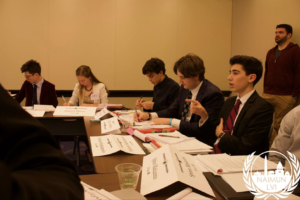Walking into the North American Invitational Model United Nations (NAIMUN) Ad-Hoc, the competitive ‘championship’ of high school crisis committees organized by Georgetown University, my worries bounced around how little I’d understood about the cryptic topic clues, how I was entering my first committee where preparation was not allowed, and how the button on my blazer was a string away from falling off.
However, prior to arriving in Ad-Hoc, what I wasn’t worried about was the gender imbalance I would encounter. After settling down and being introduced to two intimidating individuals who would chair and moderate the committee and an astoundingly large amount of crisis staffers, I soon realized that I was one of the only 4 girls in the room of 20 delegates. Additionally, out of the 6 crisis staffers in the committee, only one was a woman.
Ad-Hoc was designed to challenge delegates to think on the spot and immerse themselves in difficult topics with little preparation or knowledge on the topic. Prior to the committee, delegates were only offered a series of cryptic clues about the topics, which included ciphers and quotes from historical figures. Ad-Hoc brought together advanced delegates from around the country to compete in rigorous committee sessions, challenging their skills as crisis delegates. During the committee, I heard delegates joking about it was comparable to the ‘head-delegate’ meeting, since so many of the participants were leaders of their schools’ delegations. (Read more about it at https://bestdelegate.com/naimun-lvi-brings-back-ad-hoc/). I came prepared to test my debate and conflict resolution skills. What I didn’t expect was to find myself facing a massive gender imbalance.

Ad-hoc delegates debating at NAIMUN LVI
The gender disparity utterly surprised me, and I reached out to competitors on the high school and collegiate Model UN circuits. From them, I learned that issues of gender imbalance plague the Model UN community. There is often a low number of women delegates participating in high-level crisis committees, and those who participate often face unequal challenges.
Being primarily a General Assembly delegate, I had not noticed the gender imbalance within the crisis community and was at first taken aback. How could an activity focused so heavily on debating world issues such as gender equality have such a huge gender issue of its own? We work constantly in our committees to create solutions through directives and resolutions. As skilled problem-solvers, why can’t we do the same to solve this gender imbalance?
The first step to finding effective solutions is addressing the root of the problem. Why does this gender balance exist? Ad-Hoc Crisis Manager Margaret Hodson points out the gender bias in and out of committees is a key issue. “Competent, confident women are often perceived as more aggressive than their male peers that display similar behavior,” she said. “As such, women can be unfairly painted as ‘b*tches’ or ‘snakes’ when men with the same behavior don’t receive such labels”. These labels can disincentive other delegates from collaborating with women, which can disadvantage them in joint personal directives, bloc building, or getting sponsors for directives.”
In crisis committees, the debate is more individually focused and delegates are encouraged to follow their individual ‘crisis arcs’ to shape the path of the committee. Competitiveness is often what is expected from delegates when awards are being deliberated and performances are ranked. However, women are often shunned for exhibiting competitive behavior, and this creates a dilemma for those interested in participating in crisis, especially in the fast-paced and more competitive committees such as Ad-Hoc.
Ad-Hoc chair Suraag Srinivas also sees the competitive nature as a barrier for women participating in crisis. “There’s a lot of problems especially with what people expect and assume of delegates in crisis committees- A lot of the time snake-y and aggressive things are what’s assumed to be the norm and assumed to be what is required to award,” he said. With delegates working towards their individual crisis arcs, collaboration is often not emphasized as much as when delegates are forced to cooperate in blocs to draft resolution in General Assemblies or specialized committes.
Women using competitive tactics that men routinely employ to succeed in these committees are often labeled as “bossy” or “overbearing.” The unique expectation placed on women of being collaborative in a competitive environment serves as a barrier for women to succeed in committees.
There is also an unfortunate notion that women do not belong in these competitive environments prevalent in the committee selection process, which occurs prior to a Model UN conference. Model UN advisers and teams select which of their students will compete in the most prestigious crisis committees, and the gender inequality in NAIMUN Ad-Hoc reflects the implicit biases of the individuals making decisions. Women might be placed by their MUN teams in General Assembly or specialized committees due to the belief they would do better in a particular environment. This bias reduces the opportunity for female participation in crisis committees.
The lack of representation creates a cycle in which women are reluctant to participate because they know that they will be a minority within the committee. This cycle continuously harms and disadvantages women. It can be difficult to establish alliances when you are one of the only women in the room; meanwhile, ‘boys clubs’ are easily formed. During periods of unstructured time, such as unmoderated caucuses or even lunch breaks that functionally continue committee, the experience can be an especially grueling for women being ignored or talked over. This type of environment can make delegates reluctant to return, and the crisis circuit becomes susceptible to losing the already scarce women participants it has.
In order to create a more equitable environment, we must end the notion that women don’t belong in the competitive environment of crisis committees. Steps can include outreach efforts to high school and college MUN teams to encourage women participation in crisis. Outreach efforts can help reduce the notion that many teams seem to implicitly hold that MUN teams which women should participate in GAs rather than in crisis committees.
Another solution is increasing awareness. Gender imbalance is endemic in Model UN, and all delegates participating should be made aware of these issues. In the past, Georgetown’s MUN team has hosted ‘Women in MUN’ round tables. “Georgetown has run Women in MUN sessions, and it has helped to increase awareness amongst our team about the challenges female delegates face,” explained Hodson. This not only helps encourage women to participate in crisis committees by being prepared for these challenges, but it also helps male delegates serve as effective allies in the MUN community. (Read more about it at https://bestdelegate.com/how-to-run-a-women-in-model-un-program/). Schools can adopt similar approaches to encourage women to participate in crisis committees. Teams need to have honest conversations about gender issues on the Model UN circuit so that informed delegates can make conscious choices and help mitigate, rather than reinforce, societal biases.
On the conference organizational level, chairs and crisis staffers should be aware of gender-based challenges so they can work to reduce the obstacles faced by women in a room. “Chairs and Crisis Managers must be fully aware of the biases and obstacles that women face in crisis and take this into account,” Hodson said. “Especially when considering performance within the context of awards deliberation. When possible, the staffing of committees should ideally include an equal representation of women and men.” Srinivas also agrees with this point. “A lot of it falls on staffers to change the criteria of what kinds of behavior we reward in committees, but also on delegates to set standards for how they interact in committee,” he said. “ Ultimately though, if we as staffers don’t reward collaboration, substance, etc. then no one will do anything differently, so I think a lot of the agency falls on staff to lead that change.”
Ad-Hoc showed me an unfortunate side of an activity which I am passionate about. While the problems of gender under-representation are prevalent in the MUN circuit, it is important that we do not come to accept this norm. We need to openly discuss gender equity in MUN as we strive to change the dynamics of crisis committees.


